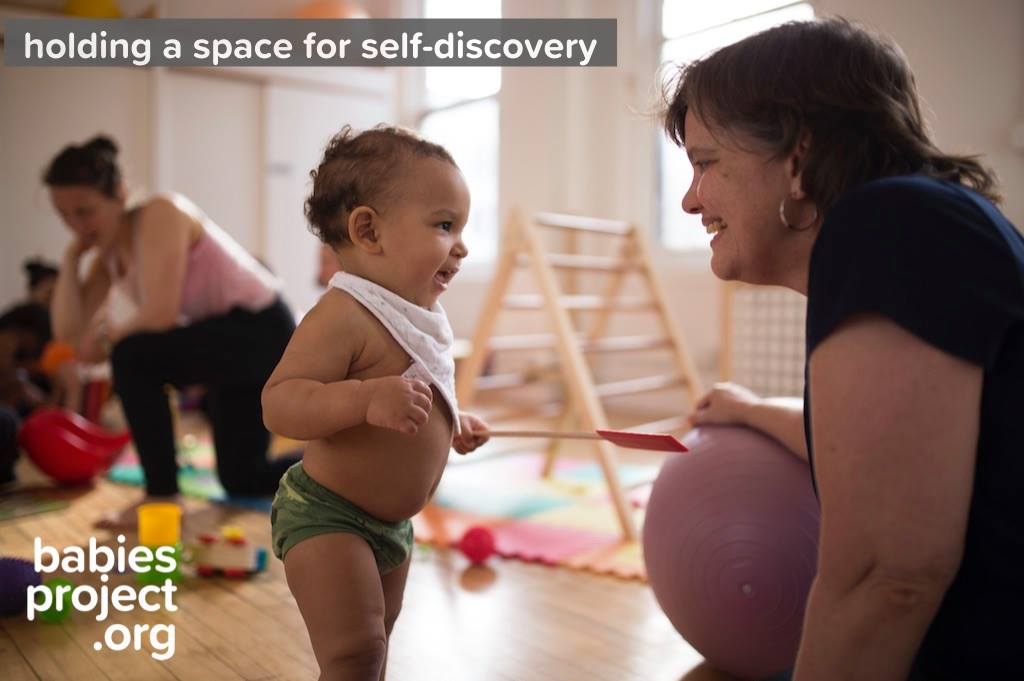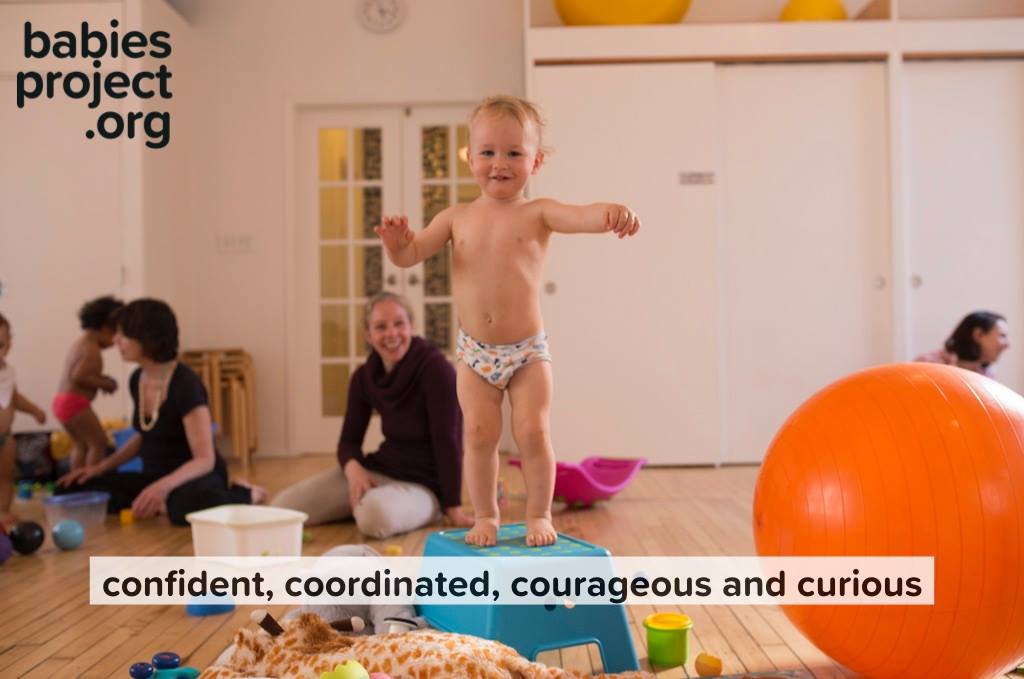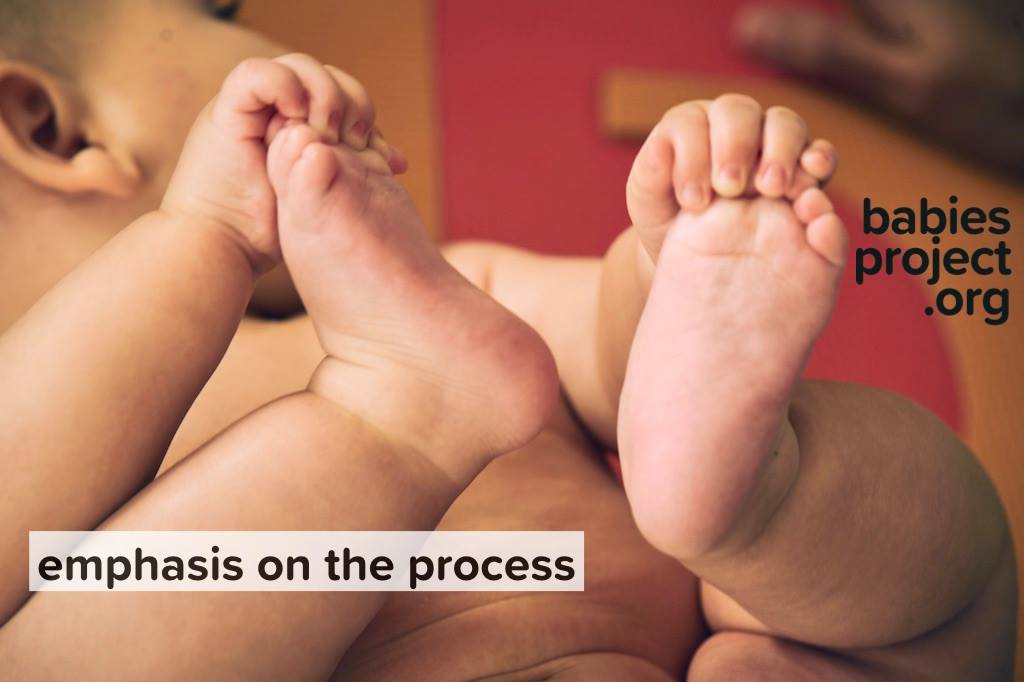Embodied Learning, Starting as Infants
An Interview with Amy Matthews, Cofounder of Babies Project
BY EMMALY WIEDERHOLT
Amy Matthews is co-founder of Babies Project in NYC, an educational non-profit offering developmental movement education for infants, toddlers, parents, caregivers, adults and elders. The organization’s vision is to create a world where babies and adults get the touch, support and movement they need to thrive. Here, Amy shares how the principles of Body-Mind Centering® and Infant Developmental Movement Education inform her belief that embodiment is fundamental to health and a deep understanding of self.
~~
Can you share with me a little about your personal history and how you became interested in different movement analyses/modalities?
I started in dance and theater. My undergraduate degree is in theater and philosophy. I danced throughout college and, when I finished school, I went home to Omaha, Nebraska and worked for a theater company. I was a director and choreographer by training and was teaching dance and making work. I realized while I was doing this that I had technical language but not a body-based or experiential language. As far as dance, I could teach some kind of ballet, Graham or Horton class, but I didn’t know how to teach movement in a general way. In the theater company I worked for, we did an original piece about Frida Kahlo. Two performers – one dancer and one actor – played Frida. The conversations I had to have with each of them were so different; one worked within the language of acting and the other in dance. I thought: There must be a common language for talking about movement that isn’t technique based with a right and wrong way to execute a movement.
Around that time, I got a job at a tiny rural college, and they hired me to teach jazz dance. It wasn’t where I wanted to start with beginning movers, but I didn’t have a way to teach movement more generally. All these questions led me to Laban Movement Analysis (LMA). I had done a tiny bit in college, but in order to learn more, I went to New York City to do a workshop. I fell in love with the material, did the year-long program, became certified, and stayed in New York City. Laban Movement Analysis fulfilled my desire for philosophical underpinnings and analytical questions like what the body is doing in relationship to space, dynamics of flow, and biomechanics. That certification is a process in engaging in observation, not getting to a right kind of movement. If I’m observing myself and see I’m making the same choice over and over again, with Laban Movement Analysis, I can make new choices, for example about rhythms or phrasing. That exploration of doing what’s unfamiliar is an intensely personal exploration. It asks: How do I know myself?
In the course of doing LMA, I was exposed to a little Body-Mind Centering (BMC), particularly the developmental work. We looked at how infants learn to roll, sit, stand, move and walk. These are the building blocks of how adults move as well. That little bit interested me, and I wanted to learn more. I intended to just study developmental work, but I ended up getting the complete certification in BMC, which is now mainly what I do.
To me, the value and excitement of BMC is asking: Can we can recognize what we’re doing? Are we doing what we intend to be doing? Can we make different choices? How do we roll, change levels, push or yield? Exploring those questions becomes a toolbox.
Following those questions is what led me into doing what I’m doing now. I don’t make theater or dance anymore. I wasn’t so excited about performance; I was more excited about process. By switching over into these somatic practices, I get to rehearse forever.
Can you describe what Babies Project is for someone unfamiliar with it?
One aspect of BMC is the study of developmental movement, which is looking at how we learn to move as infants and what impact that has on us as adults. There is a part of BMC, called Infant Developmental Movement Education, that gives addition training in how to work directly with infants and helping their caregivers learn how to pick them up, set them down, touch, and handle them. It addresses how to interact with infants to support them in that beginning learning process.
I spent a long time working with dancers and yoga practitioners with developmental movement as a question for how to inform their movement process. In 2008, I did the training to become an Infant Developmental Movement Educator (IDME). There is something amazing about working with infants and their caregivers (and by caregiver, I mean anyone who interacts with babies).
I was running a space called The Breathing Project with another yoga and anatomy teacher, Leslie Kaminoff. In that space, I started a class in 2008 for babies and their caregivers. It was by donation; I just wanted to offer the work. Over time, different IDMEs came and worked with me, including my friend and co-founder of Babies Project, Sarah Barnaby. Eventually the by-donation babies class grew to twice a week and more than 15 babies a session. When The Breathing Project ended its programming, Sarah and I decided to take over the space and turn it into Babies Project.
Babies Project is a space for infants and their caregivers to learn about touch, handling and developmental movement. We sometimes facilitate the babies directly, but mostly what we do is help caregivers know how to be with babies. It’s based in BMC and also references attachment theory, and is very much baby-led, meaning that our assumption is that we don’t have to teach the babies anything. From a BMC perspective, if they have their needs met around survival, comfort and safety, they will bond with the earth and with their caregivers. From that bonding, they will get curious. We just need to remove the obstacles to their curiosity. We’re not interested in time-based milestones; they don’t need to be doing a certain thing at six months. Faster isn’t better. We simply ask how we can support them at getting to the next level. Within reason, if an infant takes longer to learn something, they end up being more skilled at it, like how to roll or how to get into sitting. We strongly encourage caregivers to not put the baby in vertical positions they can’t get themselves into. The transition is more important than the position. If they know how to get into it, they learn how to get out of it, which means they know how to fall. Falling is important. If they don’t know how to fall, they brace and hold, which is not conducive to resilience, curiosity and learning.
There’s a lot of attention given to education for toddlers and older children. But in the world of birth to three years old, a lot is happening that there isn’t yet a lot of education around. We want to fill in that gap. Babies and caregivers are cultivating a relationship from the beginning. The way we touch and handle them in their first weeks of life set up patterns that have repercussions all the way through their lives. So part of what Babies Project is doing is filling a gap in education about what happens from birth to walking.
There are programs around the world that offer IDME certification, but not a lot of spaces dedicated to offering IDME (Infant Developmental Movement Education) to the public. Babies Project is one, and there’s another in Europe. There are individual IDMEs working all over the world. As far as finding out about Babies Project, people do find us on Google, but most are usually referred by moms’ groups. That is how it works with individual IDMEs as well. They will work with one mom who will refer them to another mom, and perhaps they might do a babies group in someone’s house. It’s out there but you have to know what to look for. By being a designated space, we’re helping people to know this work exists.
How might an understanding of infant movement patterns apply to an adult?
Our adult movement patterns are built on how we learned to move in our first years of life. One way of looking at movement education is to just replicate or mimic the shape. Another is to break it down into its component parts. If someone has difficulty landing from a jump, for example, you can tell them to just bend their knees when they land. Or you could have a whole conversation about their relationship with the floor: How do they feel their weight? What happens when they bend their knees? Do they feel like the floor will support them? Learning to give weight and receive support underlies our ability to push and shift our weight. Shifting our weight gives us a sense of ourselves that then lets us connect to the world around us. Babies will reach, grab and pull something to them. That action gets them to a new level where they have to start the process from the beginning and yield again. These are all developmental questions: When I get to a new level, how do I feel supported?
If someone is having trouble landing from a jump, from a developmental perspective, it’s important to unpack layers to the point where there’s a question and then build it back up from there. Maybe it’s difficult to land a jump because the legs might not know how to connect to the spine. Crawling is one of the first places where the legs connect to the spine. Crawling also involves weight shifts from side to side. If that’s too difficult, we can go back to rolling, which is a question of how the arms connect to the spine. We can unpack things all the way to the embryological experience. Fluid movement patterns are still available to us – we can use them, ignore them, override them, or get stuck in them. This application could be used in dance, but also just in walking. It ends up being a huge toolbox for how to understand movement.
Sarah teaches a class for elders about getting up from and down to the floor. It’s the reverse process as infants. Or, if you’re a caregiver, how do you get up and down off the floor while holding a baby? Or if you have an injury? Anyone who is engaged in movement – which is everybody – must work through these questions.
From your point of view, do somatic modalities support the social model of disability or the medical model of disability? Or perhaps it’s a new way of looking at disability and ableism?
I don’t know about all somatic modalities; some believe there is a right way to organize the body. From a BMC perspective, we meet people where they are. This could still be interpreted as getting them to an idealized place, but that’s not what it is. BMC is not about having one single experience. There’s not one right way to experience your heart, for example. Instead, we may do an exploration of feeling your heart. We’ll teach where the heart is located and then ask how you feel it in yourself. Then, in a BMC class, we’ll go around and share our experiences. People are asked not to compare their experiences. In that happening, we fill the space with different experiences. That’s what becomes the body of work in BMC. Bonnie Bainbridge Cohen, who founded BMC, is adamant that you don’t have to have a certain experience. She talks about BMC not as a technique, but as an approach. This might seem hairsplitting, but a technique has a goal. An approach is comprised of questions to see what happens. I can use BMC to explore ballet, contact improv, movement choices in a wheelchair, or rock climbing. The spirit of it is how I experience whatever the question is. This deepens my experience and helps me know my own body.
This ties right back to working with infants. Starting with infants, we as a culture teach people that they have to ask someone else if they are doing it right or feeling the right thing. It amounts to: Am I good enough? All of that is put in the hands of someone else – a teacher or doctor – and it is all externalized. I know about anatomy, but I don’t know your body. When I work with someone, I might say: Here’s the theory – now, what’s your question? What’s your experience? Is my suggestion useful? How do I meet you where you are? It’s more about process and give and take. I might have something to offer in terms of questions that you haven’t considered, but you are the expert of your own experience. That’s not a common premise in the world.
~~
To learn more, visit babiesproject.org.



